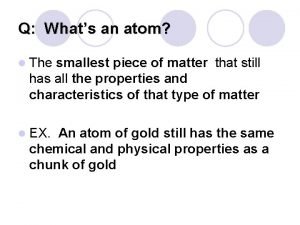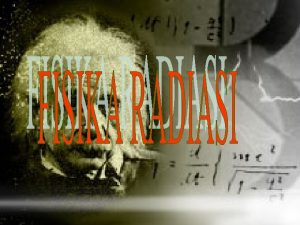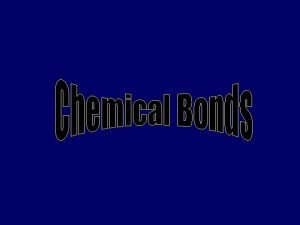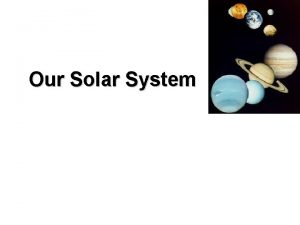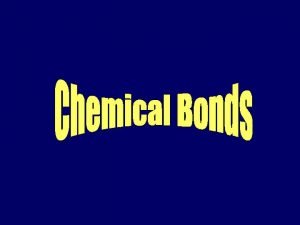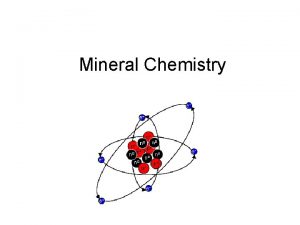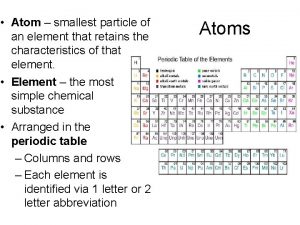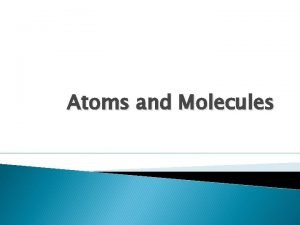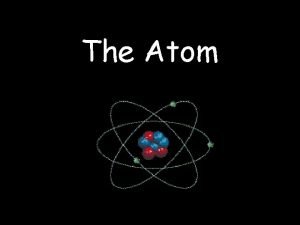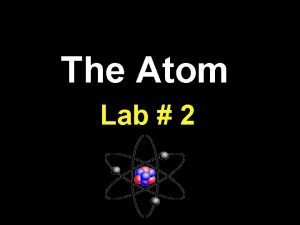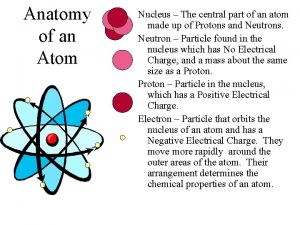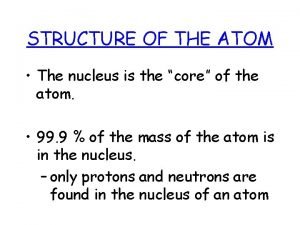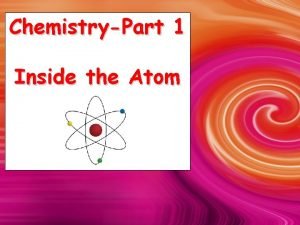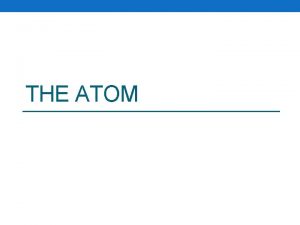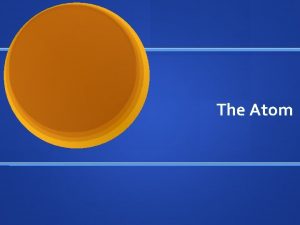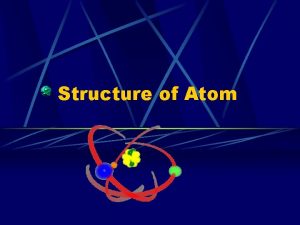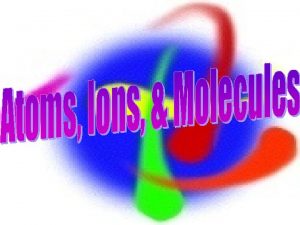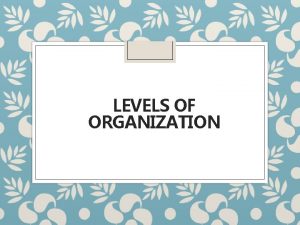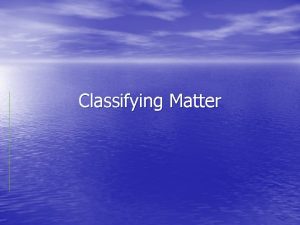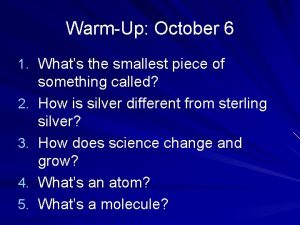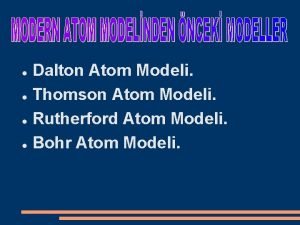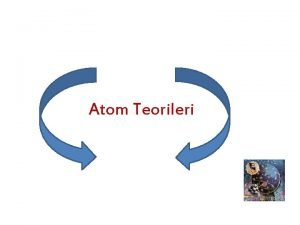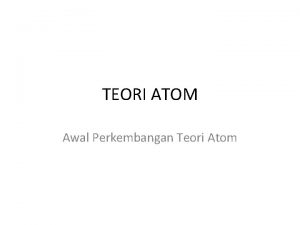Q Whats an atom l The smallest piece




















- Slides: 20

Q: What’s an atom? l The smallest piece of matter that still has all the properties and characteristics of that type of matter l EX. An atom of gold still has the same chemical and physical properties as a chunk of gold

Q: What’s an atom? l Brownian Motion ¡ Perpetual movement of particles (atoms jiggling/vibrating) ¡ Named after Robert Brown (Scottish botanist).

Q: What does an atom look like? l An atom is mostly empty space l Atoms have a small, dense nucleus at their center l Atoms contain what we call subatomic particles (3 subatomic particles)

Q: What does an atom look like? (3 subatomic particles) l Electron ¡ ¡ ¡ (symbol e-) Location- electron cloud (outside nucleus) Charge- negative (each electron has a -1 charge) Relative mass- 1/1840 l 1/1840 the size of the other particles = SMALL

Q: What does an atom look like? (3 subatomic particles) l Proton ¡ ¡ ¡ (symbol p+) Location- nucleus Charge- positive (each proton has a +1 charge) Relative mass- 1

Q: What does an atom look like? (3 subatomic particles) l Nucleus ¡ ¡ ¡ (symbol n 0) Location- nucleus Charge- neutral (each neutron has zero charge, not charged at all!) Relative mass- 1

Draw a picture of an atom below. Label each of the three subatomic particles, as well as the nucleus and electron cloud.

Q: What is the overall charge of the nucleus in an atom? Why? l Nucleus is made of protons and neutrons (p+ and n 0) l Since the only charged particles are protons and they have a positive charge, the overall charge is positive

Break Time l Structure of the Atom Worksheet (Chem. Quest 8) with questions ¡ Use the diagrams and information on the front of the sheet to answer the questions on the back.

Q: What is the Periodic Table? l Where ¡ we can look to find elements Any element in the world is found here. If it’s not here, it’s not an element. ¡ For example: Hydrogen and oxygen are found on the PT (H and O), they are both elements. l Water is made of these elements (H 2 O), but is not found on the PT. Water is a COMPOUND, not an element l

Q: What is the Periodic Table? l The table is organized based on physical and chemical properties/characteristics of elements such as: ¡ What will happen when it is mixed with a certain chemical? ¡ How many of each subatomic particle are present? ¡ What state of matter is it at room temperature? ¡ What does it look like (shiny, dull, etc)? ¡ How big is an atom of that element?

Q: How do I read the periodic table? l First, you must realize that each box contains information about ONE ELEMENT

Q: How do I read the periodic table? l The smaller number in each box (usually at the top) is called the atomic number. ¡ Tells us how many p+ an atom of that element has ¡ Tells us how many e- an atom of that element has l *** This is true ONLY if the atom has an overall NEUTRAL CHARGE

Atomic Number 8 O Oxygen 15. 999 Atomic Number

Q: How do I read the periodic table? l The larger number (usually at the bottom) represents the atomic mass. Measured in amu (atomic mass units) ¡ Tells us the total number of p+ and n 0 in an atom ¡ How can I use this to find JUST the number of n 0? ¡ Atomic mass – Atomic number = # n 0 l Atomic mass MUST be rounded to the nearest whole number l

Atomic Mass 8 O Oxygen 15. 999 Atomic Mass (amu)

Q: How do I read the periodic table? l Chemical Symbol Usually one or two letters ¡ Some have three letters- these are manmade and will likely get renamed. ¡ First letter is always capital, second is always lowercase ¡ Some symbols are based on the Latin names for the element ¡ l Ex. Aurum – gold – Au Ferrum – iron – Fe

Chemical Symbol and Name 8 Chemical Name O Oxygen 15. 999 Chemical Symbol

Example: Find the element Bismuth (Bi) on your PT. l Atomic Number: 83 l Atomic Mass: 207 (approx) l Symbol: Bi l # p+ = 83 l # e- = 83 l # n 0 = 124 (207 – 83)

Agenda Items l Atomic Math Challenge- due tomorrow
 Atom
Atom The smallest piece of an element
The smallest piece of an element Whats the smallest unit of matter
Whats the smallest unit of matter The structure of the atom section 2 defining the atom
The structure of the atom section 2 defining the atom Kelemahan model atom dalton
Kelemahan model atom dalton Whats the second smallest planet
Whats the second smallest planet The smallest unit of an ionic compound is a
The smallest unit of an ionic compound is a Whats the smallest particle of matter
Whats the smallest particle of matter Whats the smallest particle of matter
Whats the smallest particle of matter Whats the smallest particle of an element
Whats the smallest particle of an element Whats inside a nucleus
Whats inside a nucleus Whats inside of an atom
Whats inside of an atom Central part of the atom
Central part of the atom Whats found in the nucleus of an atom
Whats found in the nucleus of an atom Whats inside an atom
Whats inside an atom Hình ảnh bộ gõ cơ thể búng tay
Hình ảnh bộ gõ cơ thể búng tay Lp html
Lp html Bổ thể
Bổ thể Tỉ lệ cơ thể trẻ em
Tỉ lệ cơ thể trẻ em Voi kéo gỗ như thế nào
Voi kéo gỗ như thế nào Tư thế worm breton là gì
Tư thế worm breton là gì
